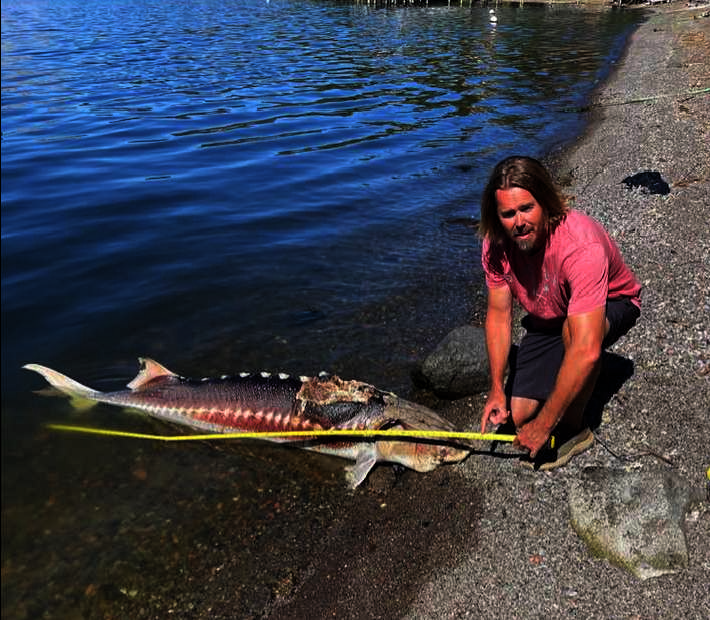
LAKE COUNTY, Calif. — When people think of fish in Clear Lake, they tend to associate it with bass, catfish and the hitch.
So the appearance this week of a sturgeon — a fish not known to be at home in Clear Lake — has both startled and baffled fishing enthusiasts, lake lovers and scientists alike.
Based on its shape and color, the big fish in question appears to be a white sturgeon, an ancient fish that’s the largest freshwater fish in North America.
The sturgeon ended up on the beach on property owned by Ken Young, a Buckingham resident.
Young told Lake County News that he discovered the fish on Monday afternoon when a fisherman offshore was yelling at him to go take a look.
“I thought he was crazier or drinking too much but no, he was right. It’s huge,” Young said.
Young shared a photo of the fish being measured by another man. He said it is 7 feet long and estimated it could have been 150 pounds.
Young said he had a biologist come by to take samples to make sure the fish wasn’t dumped here and to determine if it was real. He said he also reached out to the California Department of Fish and Wildlife but that they hadn’t responded.
What makes the discovery so noteworthy is that sturgeon are not known to be in Clear Lake’s waters.
A University of California webpage for fish native to Clear Lake lists 14 species. Nowhere on that list is the sturgeon.
Additionally, introduced fish — including bass, carp and catfish — make their homes in the 69-square-mile eutrophic lake.
The California Department of Fish and Wildlife, or CDFW, reports that there are 25 species of sturgeon worldwide, and of those two are known in California — the white and the green.
The white, like that found on Young’s beach, is larger than the green. While the Buckingham sturgeon, at 7 feet, is a huge fish for Clear Lake, for the species overall, it’s on the smaller side, with CDFW biologists reporting that white sturgeon can grow to be as long as 20 feet.
A first for Clear Lake
Lake County News contacted CDFW to ask about the sturgeon’s discovery.
“That’s a first for Clear Lake as far as we know, but it’s not impossible,” said CDFW spokesman Peter Tira in an email response.
As for how the sturgeon got into Clear Lake, Tira offered one possible explanation.
“There was a period of time when people were planting white sturgeon everywhere and they turn up in various reservoirs throughout the state on occasion,” he said.
“Clear Lake is a bit warm to support sturgeon but then again sturgeon are far more tolerant of warm temperatures than some other species and very adaptable in terms of what they eat. So all of this is certainly plausible, but not part of a white sturgeon’s natural or historic range,” Tira said.
Tira told Lake County News that none of CDFW’s local biologists or staff had seen the fish in person as far as he could tell.
In response to a question about the possibility of the fish migrating from the Bay Delta — which the waters of Clear Lake feed into — Tira responded, “Clear Lake is not part of its native range so there is almost no way it could have entered through the Delta.”
He reiterated, however, “people years ago moved white sturgeon around and introduced them to many large lakes and reservoirs throughout the state for fishing opportunities so they do turn up on occasion in unexpected places outside of their native range.”
An ancient fish
CDFW’s white sturgeon information page said it’s a very long-lived fish with a slow growth rate that can live a life as long as a human.
The oldest white sturgeon on record was 103 years old at the time of capture, “but most fish in the Delta are now believed to be less than 20 years old,” CDFW reported.
White sturgeon are a candidate species for listing as threatened under the California Endangered Species Act, while green sturgeon from the southern population were listed as threatened under the federal Endangered Species Act in 2006, CDFW reported.
Additionally, CDFW said the northern population green sturgeon are not state or federally listed, but they both are categorized as a state species of special concern.
Sturgeon also are under threat across the globe. The IUCN Red List of Threatened Species lists 85% of sturgeon species as being considered to be at risk of extinction.
White sturgeon in California are catch and release only, and fishing is only allowed at certain times of the year.
In its “Conserve the Sturg” video, CDFW staff reported that white sturgeon can grow to 20 feet and 1,500 pounds, although smaller ones are more common in the 4- to 6-foot range, and even up to 7 feet.
The sturgeon is one of the oldest fish species in California, with fossil records dating back to the early Cretaceous period, more than 200 millions years ago, CDFW said.
The primary population is in the California Delta, including the Sacramento and San Joaquin rivers and the San Francisco Bay Area.
Over the last quarter century, CDFW estimates there has been an 80-percent reduction in white sturgeon numbers.
Habitat loss has contributed significantly to the white sturgeon’s decline, along with overharvesting and poaching, CDFW said.
More recently, CDFW harmful algal blooms have impacted the fish.
The discovery of the dead sturgeon coincides with a fish dieoff that’s been taking place in Clear Lake since the start of this month that CDFW is attributing to a lack of dissolved oxygen in the water.
Scientists have reported that such conditions can harm white sturgeon just like they do other fish.
A big lake
Lake County News reached out to Lake County Water Resources Director Pawan Upadhyay to ask if he had information about the fish’s discovery, but did not receive a response on Tuesday.
Angela De Palma-Dow is a scientist and water resources professional who serves as executive director of the Lake County Land Trust, formerly worked as invasive species coordinator for Lake County Water Resources and is the author of Lake County News’ “Lady of the Lake” columns.
She said she also is working to track down more information on the discovery.
De Palma-Dow said she got her report from a county fisheries biologist.
“Apparently everyone is shocked .... even the long time fish biologists and fishers,” she said in an email response to questions from Lake County News.
Similar to Tira, De Palma-Dow suggested the sturgeon likely was released in Clear Lake when it was younger, much like goldfish and carp were.
“Maybe from a bait bucket, or someone caught a small one that was under the allowable size and released it ...we don't know!” she said in an email.
De Palma-Dow added that, ultimately, how the fish got to Clear Lake could be the story.
She pointed out that Clear Lake is huge. “What else could be in this lake that we don't know about?”
Email Elizabeth Larson at

 How to resolve AdBlock issue?
How to resolve AdBlock issue? 



